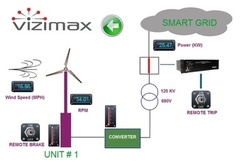02/11/2012
Product Pick of the Week - Vizimax’s RightWON
Transformers serve as a hub for collection and distribution of energy changing the voltage level at different locations of the grid. They are a key component of the Smart Grid, loosely defined as an automated, widely distributed energy delivery network, characterized by a two-way flow of electricity and information, and capable of monitoring everything from power plants to customer preferences to individual appliances.
There is some ways to go before the vision of the Smart Grid is realized, but recently monitoring transformers has taken a leap forward, as energy production sites seek solutions to lower maintenance costs. Remote monitoring is seeing increasingly wider use especially remote wind farms and solar-powered production sites where having someone present to monitor transformers at fixed intervals is a costly proposition. As more renewable energy production sites come online, utilities have been investing in monitoring technology that keeps labor costs to a minimum.
Predictive maintenance gains favor over preventive:
Remote monitoring and communication capabilities let utilities conduct “predictive” maintenance of transformers, which means conducting maintenance only when a parameter starts deviating from a pre-set standard. This typically does not occur at a pre-determined interval. Remote management let operators“see” how a transformer is operating and send someone to fix it only when it’s necessary.
Daniel Lambert, of Vizimax, a Montreal, Canada-based company that offers remote monitoring and control systems for public utilities and the industrial and private sectors, notes that remote management is being widely embraced, especially as operators need more profitable maintenance functions. “It is similar to today’s cars that tell you when to change your oil or conduct other maintenance based on specific driving habits,” said Lambert. “Rather than changing your oil at 6,000 mile intervals, electronic sensors can determine if you do mainly city or highway driving and signal the need for an oil change accordingly. That basic principle has been adapted for use in monitoring transformers.”
When maintenance is done purely in preventive mode, operators have no idea what is really happening inside and next to the transformer, and may tend to unnecessarily shorten intervals between each maintenance activity. With predictive monitoring, utilities can save money by having a real understanding of the key transformer parameters, which include temperature, liquid level, pressure vacuum, outgoing voltage, and ingoing voltage.
Utilities that conduct preventive maintenance programs usually use either time or quantity of energy consumed as the determining factor. Once they install remote monitoring capabilities, most switch to predictive-maintenance modes. Payback on the investment in remote monitoring equipment is estimated between 9 and 15 months.
Among those moving in the direction of this type of remote monitoring are GE, Siemens, Alstom Grid (Areva T&D), Schneider Electric, BHEL, Crompton Greaves, New York Power Authority, National Grid, Power Grid of India, and Hydro-Quebec, among others.
Building transformers that incorporate digital monitoring:
Many transformer manufacturers are recognizing this growing demand for online transformer monitoring products and diagnostic services, and investing in building them, especially for step-up transmission, high-voltage transformers.
These technologies will be critical for improving grid reliability and helping utilities avoid transformer failures and resultant blackouts. They will also reduce maintenance costs and defer capital expenditures by extending a transformer’s useful life.
In addition to monitoring vital statistics such as temperature, pressure, and vacuum levels, there has also been a burgeoning interest in conducting dissolved gas analysis (DGA) of the oil in transformers. A DGA takes samples of an oil’s exhaust gases to determine if events have occurred that might be detrimental to the transformer and reduce its life. Industrial transformer maintenance people and utilities are setting up these planned sampling programs, using online devices that can monitor oil quality.
This can greatly improve reliability, because users will know in advance when something has to be replaced, rather than risk unscheduled outages. For food-processing plants and mills, which can lose millions of dollars when power is interrupted, this type of sampling program is being undertaken to ensure reliable power.
Transformers in place now are already using various smart devices for load switching. In the 21st century, the move will be towards monitoring systems that promote transformer reliability. Ensuring reliability on the grid by replacing equipment before it fails and anticipating upcoming problems is what transformer manufacturers will be focusing on.
Remote monitoring equipment:
The latest technology used for remote transformer monitoring includes a combination of a remote terminal unit, a programmable language controller, a gateway (a network node equipped for interfacing with another network that uses different protocols), and a protocol converter. The complete monitoring system is usually placed in service by a system integrator or a power manufacturer.
An example of one such system is Vizimax’s RightWON, a secure, modular, rugged automation remote terminal unit (RTU), programmable logic controller (PLC), gateway, communication conversion protocol platform that connects circuit breakers, transformers, IEDs, meters, sensors, control and monitoring devices at the substation level or anywhere on the distribution network. In addition to energy applications, the monitoring devices are used in water and telecommunications monitoring.
The unit is for remote management applications, providing support for equipment through its data acquisition, monitoring, control and remote maintenance functions. At renewable energy sites, the system shuts down and locks circuit breakers (CBs) and inverters remotely, which avoids traveling to an energy-production site for distribution-line maintenance. The production site is still operational while maintenance is occurring on the network.
The unit is often used in substations, where it usually connects to transformers, circuit breakers, intelligent electronic devices (IEDs), protective relays, and meters through the electric utility’s private network. In some instances, in can be used strictly for monitoring transformers in substations, using wireless connectivity (through GSM, GPRS, 3G or CDMA networks). Parameters such as temperature, liquid level, pressure vacuum, outgoing voltage, and ingoing voltage will be measured and transferred to a utility’s supervisory control and data acquisition (SCADA) system. Wireless monitoring calls for specialized Web service interfaces.
The system makes it economical to conduct monitoring, because it can convert older controls and sensors already implemented to newer communication protocols without having to replice or modify them. The monitoring system connects to the SCADA using fiber optic cables or web interface through a wireless device. It offers a remote and local view on event logs charting key assets status changes and alarm signals about exceeding thresholds.
Remote access is made possible through networking, security, and telecommunication functions, and is supported by a broad range of integrated interfaces. These interfaces support a wide variety of industrial protocols (IEC 61850, DNP3, ModBus, and IEC 60870) as well as Web access and remote maintenance functions. The information collected is easily viewed on smart phones from anywhere, any time. The system supports sending notifications by email, text messages, or pager. Users who receive a message can access the system using a Web browser to view the data and operate the site remotely.
The system is IEC 61850 KEMA certified and can also be used for a variety of other Smart Grid applications, including remote default detection and automated reclose/disconnect operations within distribution networks, and alarms and operational data broadcast and commands, usually to or from the SCADA of power utilities, IPPs, integrators and equipment manufacturers’ team management applications.
Monitoring equipment also used in re-energizing transformers:
In addition, new flux management monitoring technology is being deployed more at the end of transmission lines during re-energizing a transformer, a regular process that takes place every time a production site connects to the grid. The need to re-energize varies considerably, but there are always times when required maintenance requires stopping the connection between the production site and transmission lines. When maintenance is completed, the transformer must be re-energized.
The flux management units avoid network inrush that may create network outages while transformers are re-energized, something that in the past had been a frequent occurrence. This is extremely important, because several hours of lost revenue in a month can mean the difference between a profitable energy production site and an unprofitable one.
The system calculates the residual flux while a transformer is reenergized at the last operation, and ensures that the next transformer operation is performed at the exact millisecond such that residual flux is identical to the previous operation, which minimizes current inrush and stress on both the high voltage transformer and circuit breaker.
The unit measures relevant parameters from the transformer and sends a command to the circuit breaker of the transformer to achieve this operation. Using this equipment increases the quality of the network, decreases network outages, and decreases the frequency and the cost of maintenance operations.
Last thoughts:
Remote monitoring makes it possible to manage maintenance of remote power equipment in the field in a predictive mode instead of the more traditional and more expensive preemptive or preventive mode. By remotely monitoring power equipment in remote locations, electric utilities now only must execute maintenance operations on their equipment when it is required. This is going a long way to cutting costs for the many renewable energy production sites that are coming online.
Special Thanks to Vizimax, its Authors as well as photographers for providing the contents of this article.
For more information on this article or if you would like to know more about what www.windfair.net can offer, please do not hesitate to contact Trevor Sievert at ts@windfair.net
www.windfair.net is the largest international B2B Internet platform – ultimately designed for connecting wind energy enthusiasts and companies across the globe!
There is some ways to go before the vision of the Smart Grid is realized, but recently monitoring transformers has taken a leap forward, as energy production sites seek solutions to lower maintenance costs. Remote monitoring is seeing increasingly wider use especially remote wind farms and solar-powered production sites where having someone present to monitor transformers at fixed intervals is a costly proposition. As more renewable energy production sites come online, utilities have been investing in monitoring technology that keeps labor costs to a minimum.
Predictive maintenance gains favor over preventive:
Remote monitoring and communication capabilities let utilities conduct “predictive” maintenance of transformers, which means conducting maintenance only when a parameter starts deviating from a pre-set standard. This typically does not occur at a pre-determined interval. Remote management let operators“see” how a transformer is operating and send someone to fix it only when it’s necessary.
Daniel Lambert, of Vizimax, a Montreal, Canada-based company that offers remote monitoring and control systems for public utilities and the industrial and private sectors, notes that remote management is being widely embraced, especially as operators need more profitable maintenance functions. “It is similar to today’s cars that tell you when to change your oil or conduct other maintenance based on specific driving habits,” said Lambert. “Rather than changing your oil at 6,000 mile intervals, electronic sensors can determine if you do mainly city or highway driving and signal the need for an oil change accordingly. That basic principle has been adapted for use in monitoring transformers.”
When maintenance is done purely in preventive mode, operators have no idea what is really happening inside and next to the transformer, and may tend to unnecessarily shorten intervals between each maintenance activity. With predictive monitoring, utilities can save money by having a real understanding of the key transformer parameters, which include temperature, liquid level, pressure vacuum, outgoing voltage, and ingoing voltage.
Utilities that conduct preventive maintenance programs usually use either time or quantity of energy consumed as the determining factor. Once they install remote monitoring capabilities, most switch to predictive-maintenance modes. Payback on the investment in remote monitoring equipment is estimated between 9 and 15 months.
Among those moving in the direction of this type of remote monitoring are GE, Siemens, Alstom Grid (Areva T&D), Schneider Electric, BHEL, Crompton Greaves, New York Power Authority, National Grid, Power Grid of India, and Hydro-Quebec, among others.
Building transformers that incorporate digital monitoring:
Many transformer manufacturers are recognizing this growing demand for online transformer monitoring products and diagnostic services, and investing in building them, especially for step-up transmission, high-voltage transformers.
These technologies will be critical for improving grid reliability and helping utilities avoid transformer failures and resultant blackouts. They will also reduce maintenance costs and defer capital expenditures by extending a transformer’s useful life.
In addition to monitoring vital statistics such as temperature, pressure, and vacuum levels, there has also been a burgeoning interest in conducting dissolved gas analysis (DGA) of the oil in transformers. A DGA takes samples of an oil’s exhaust gases to determine if events have occurred that might be detrimental to the transformer and reduce its life. Industrial transformer maintenance people and utilities are setting up these planned sampling programs, using online devices that can monitor oil quality.
This can greatly improve reliability, because users will know in advance when something has to be replaced, rather than risk unscheduled outages. For food-processing plants and mills, which can lose millions of dollars when power is interrupted, this type of sampling program is being undertaken to ensure reliable power.
Transformers in place now are already using various smart devices for load switching. In the 21st century, the move will be towards monitoring systems that promote transformer reliability. Ensuring reliability on the grid by replacing equipment before it fails and anticipating upcoming problems is what transformer manufacturers will be focusing on.
Remote monitoring equipment:
The latest technology used for remote transformer monitoring includes a combination of a remote terminal unit, a programmable language controller, a gateway (a network node equipped for interfacing with another network that uses different protocols), and a protocol converter. The complete monitoring system is usually placed in service by a system integrator or a power manufacturer.
An example of one such system is Vizimax’s RightWON, a secure, modular, rugged automation remote terminal unit (RTU), programmable logic controller (PLC), gateway, communication conversion protocol platform that connects circuit breakers, transformers, IEDs, meters, sensors, control and monitoring devices at the substation level or anywhere on the distribution network. In addition to energy applications, the monitoring devices are used in water and telecommunications monitoring.
The unit is for remote management applications, providing support for equipment through its data acquisition, monitoring, control and remote maintenance functions. At renewable energy sites, the system shuts down and locks circuit breakers (CBs) and inverters remotely, which avoids traveling to an energy-production site for distribution-line maintenance. The production site is still operational while maintenance is occurring on the network.
The unit is often used in substations, where it usually connects to transformers, circuit breakers, intelligent electronic devices (IEDs), protective relays, and meters through the electric utility’s private network. In some instances, in can be used strictly for monitoring transformers in substations, using wireless connectivity (through GSM, GPRS, 3G or CDMA networks). Parameters such as temperature, liquid level, pressure vacuum, outgoing voltage, and ingoing voltage will be measured and transferred to a utility’s supervisory control and data acquisition (SCADA) system. Wireless monitoring calls for specialized Web service interfaces.
The system makes it economical to conduct monitoring, because it can convert older controls and sensors already implemented to newer communication protocols without having to replice or modify them. The monitoring system connects to the SCADA using fiber optic cables or web interface through a wireless device. It offers a remote and local view on event logs charting key assets status changes and alarm signals about exceeding thresholds.
Remote access is made possible through networking, security, and telecommunication functions, and is supported by a broad range of integrated interfaces. These interfaces support a wide variety of industrial protocols (IEC 61850, DNP3, ModBus, and IEC 60870) as well as Web access and remote maintenance functions. The information collected is easily viewed on smart phones from anywhere, any time. The system supports sending notifications by email, text messages, or pager. Users who receive a message can access the system using a Web browser to view the data and operate the site remotely.
The system is IEC 61850 KEMA certified and can also be used for a variety of other Smart Grid applications, including remote default detection and automated reclose/disconnect operations within distribution networks, and alarms and operational data broadcast and commands, usually to or from the SCADA of power utilities, IPPs, integrators and equipment manufacturers’ team management applications.
Monitoring equipment also used in re-energizing transformers:
In addition, new flux management monitoring technology is being deployed more at the end of transmission lines during re-energizing a transformer, a regular process that takes place every time a production site connects to the grid. The need to re-energize varies considerably, but there are always times when required maintenance requires stopping the connection between the production site and transmission lines. When maintenance is completed, the transformer must be re-energized.
The flux management units avoid network inrush that may create network outages while transformers are re-energized, something that in the past had been a frequent occurrence. This is extremely important, because several hours of lost revenue in a month can mean the difference between a profitable energy production site and an unprofitable one.
The system calculates the residual flux while a transformer is reenergized at the last operation, and ensures that the next transformer operation is performed at the exact millisecond such that residual flux is identical to the previous operation, which minimizes current inrush and stress on both the high voltage transformer and circuit breaker.
The unit measures relevant parameters from the transformer and sends a command to the circuit breaker of the transformer to achieve this operation. Using this equipment increases the quality of the network, decreases network outages, and decreases the frequency and the cost of maintenance operations.
Last thoughts:
Remote monitoring makes it possible to manage maintenance of remote power equipment in the field in a predictive mode instead of the more traditional and more expensive preemptive or preventive mode. By remotely monitoring power equipment in remote locations, electric utilities now only must execute maintenance operations on their equipment when it is required. This is going a long way to cutting costs for the many renewable energy production sites that are coming online.
Special Thanks to Vizimax, its Authors as well as photographers for providing the contents of this article.
For more information on this article or if you would like to know more about what www.windfair.net can offer, please do not hesitate to contact Trevor Sievert at ts@windfair.net
www.windfair.net is the largest international B2B Internet platform – ultimately designed for connecting wind energy enthusiasts and companies across the globe!
- Source:
- Vizimax
- Author:
- Posted by Trevor Sievert, Online Editorial Journalist
- Email:
- Sans-titre-22
- Link:
- www.vizimax.com/...
- Keywords:
- wind, wind energy, wind turbine, rotorblade, awea, ewea, wind power, suppliers, manufacturerstrevor sievert





























